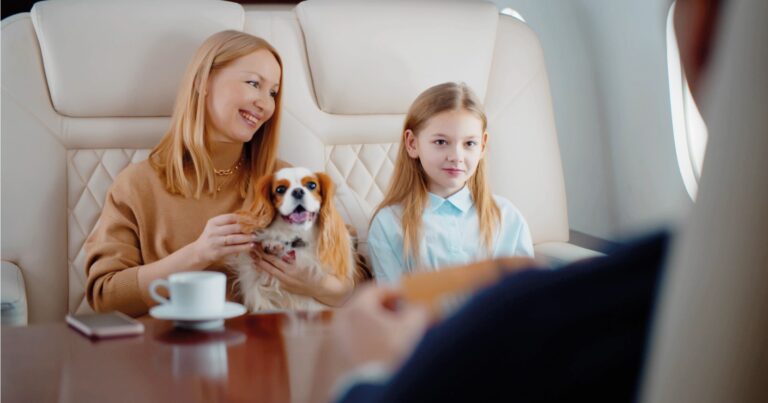According to the International Pet and Animal Transportation Association, over four million pets and other animals are transported by air worldwide every year. The logistics of this can be confusing and overwhelming for owners who are keen to travel with their pets, but flying privately can quell concerns that often arise when taking a pet on a commercial flight.
“One of the significant challenges for pet owners when flying commercially is the size restrictions imposed by airlines,” says Lance Tweden, vice president of membership at Jet Agency. “Many carriers require larger pets to travel as cargo, causing distress for both pets and owners. Depending on the breed, some pets may not be able to fly commercially at all.
“Private aviation overcomes this challenge by allowing pets to travel in the cabin with their owners, eliminating the need for cargo transport. We prioritize safety and comfort, providing a controlled environment that ensures a stress-free experience for both pets and their owners.”
Planning ahead
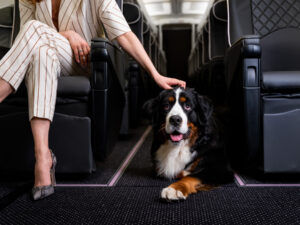
Most pets can be transported by plane, but the jet type depends on their size and the specific policies of the operators. Smaller aircraft typically accept pets in the cabin weighing up to 15kg (33lbs), while larger planes can accommodate heavier pets.
“Ensuring that your pet’s vaccinations and documentation are current is essential when traveling internationally,” says Eymeric Segard, CEO and founder at LunaJets. “Customs officials strictly enforce these requirements, so it’s vital to prepare in advance.
“We advise pet owners to consult with their veterinarian to confirm that all necessary documents and vaccinations are up to date. Remember, some vaccines become effective only after a certain period following inoculation.”
Segard advises to research specific pet entry requirements at destinations because these can
vary significantly.
Contacting local authorities, consulates and a veterinarian in the country can provide valuable insights and help verify that you meet all entry requirements.
“For instance, after the pandemic, a client traveling to the UAE with their dog encountered a unique situation where authorities mandated a Covid-19 test for the pet,” he adds. “While unusual, such stipulations are critical for certain trips.
“Likewise, the UK requires a tapeworm treatment to be administered at least 24 hours before the flight. Keep in mind that only designated airports in the UK accept traveling pets as they require the necessary facilities and veterinary staff to conduct health checks and quarantine if needed upon arrival.”
Quarantine and restrictions
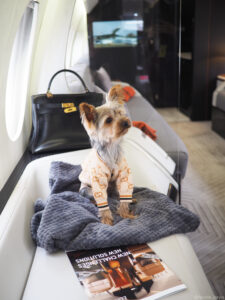
The EU Pet Travel Scheme enables pet owners to move dogs, cats and ferrets within the European Union without needing to quarantine.
The scheme is directed and authorized by the Animal and Plant Health Agency and allows owners to travel with the three species via approved charter operators on certain routes and entry ports into the UK, including Biggin Hill, Luton, Manchester and Glasgow.
The scheme has been implemented at XLR Executive Jet Centre’s Liverpool hub since 2018, and has been rolled out in Birmingham and Bournemouth since.
“Strict regulations are in place which include secure kennels, approved vehicles and a very in-depth process to follow, which includes checking of all documentation ahead of arrival and then on the day checks like microchip reading,” says Steve Barker, corporate aviation manager at XLR Executive Jet Centre’s Liverpool John Lennon Airport location. “It’s a great scheme and has had a positive impact on our customers. To be able to travel freely within the cabin with your pet puts the owner’s mind at ease.”
In addition to a tapeworm treatment for dogs, each traveling pet must have an EU Pet Passport and be vaccinated against rabies.
For pet travel from the UK to the EU, pet owners need an Animal Health Certificate, which must be issued against the pet’s record no more than 10 days before travel. This certificate is valid for four months, which means it can be applied to a series of trips within the EU or a return to the UK within this time.
Pets can only travel with approved carriers, all of which must hold a Required Method of Operation with each approved FBO at the approved airport.
“This scheme is in place to avoid the need for quarantine, provided the pet has been vaccinated,” says Barker. “If for any reason the pet fails the checks, it will either be refused entry and returned to where it came from, or put into quarantine in an approved facility for six months. There are no deviations to this regardless of which country it arrives from.”
For countries outside of the EU and UK, each country has its own set of rules regarding pet quarantine. Laws apply equally, regardless of whether you’re traveling on a private or commercial flight.
For instance, Australia and New Zealand have strict quarantine laws, requiring pets to stay in quarantine facilities for periods ranging from 10 to 60 days. Some countries have more relaxed regulations, allowing pets to
enter with minimal quarantine or with none at all under certain conditions.
“Class A dogs – which include breeds such as the American Pit Bull Terrier, American Staffordshire Terrier, American Bully and Dogo Argentino – are often subject to stricter regulations,” says Segard.
“These may include requirements for specific types of cargo crates that meet certain standards. Therefore, we must keep in mind that certain breeds, especially those deemed dangerous, may be prohibited or face particular restrictions in certain countries.”
When transporting endangered species across borders – such as some breeds of turtles, for example – Segard says it is crucial to obtain specific permits.
LunaJets strongly recommends that its clients consult the list of species protected under the Convention on International Trade in Endangered Species of Wild Fauna and Flora (CITES) to ensure that their pets are fully compliant with all required documentation for legal and safe travel.
Preparation and onboard
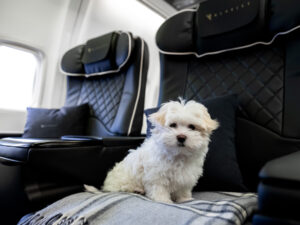
The fee for taking a pet on a private flight can cost up to US$1,000 per animal, but many operators charge nothing. Some will ask for the cost of after-flight cleaning to be covered.
This varied approach is replicated when it comes to safety, with every operator enforcing its own set of rules. Some will allow pets to roam freely inside cabins, while others will require them to be secure in their carriers for the duration of a flight.
“Generally, pet owners are asked to bring leashes and ensure their pets’ needs are met before flying, including avoiding food and drinks 12 hours prior to the flight,” says Segard.
“For the safety of the pet, passengers and crew members, owners might be advised to bring muzzles or sedatives, especially since flights can be noisy and unsettling during take-off and landing, and pets’ reactions are unpredictable – especially if it is their first flight.”
Beyond safety protocols, operators may ask for clients to bring new or freshly cleaned pet blankets and beds to help maintain the cleanliness of the aircraft cabin. This organized approach for pre-flight planning is essential, especially on the day prior and day of the journey.
“If a pet doesn’t travel well in the car, be mindful about food given before the flight,” says George Bannister, charter manager at Equinox Charter. “We can also advise on toilet breaks and any other requirements the animal may have. Should your pet find certain noisy or unusual environments stressful, consider bringing their favorite toy or stress-eliminator on board.”
Moving mountains and lions
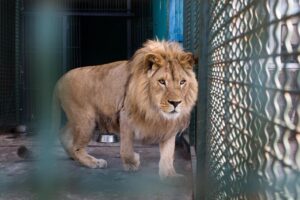
The type of pets and other animals that can be flown privately goes far beyond household cats and dogs.
In 2021, a KlasJet flight headed to the Tanzanian city of Moshi with a lion and leopard aboard. The big cats were to be repatriated to more familiar territories following a long and complex rehabilitation process.
“In usual circumstances, animals are transported by cargo aircraft,” says Lukas Petrauskas, chief commercial officer at KlasJet. “However, in this situation and to ensure that the animals’ handlers, vets and the entire repatriation team could travel together, the private jet was reconfigured to accommodate their cages by removing a section of the seating normally reserved for humans.
“In the case of a special mission, we have to get approvals from maintenance organizations and local civil authorities, and then reverse the process after the trip. It takes a significant amount of time, knowledge, effort and funds combined to accomplish a mission successfully,” says Petrauskas.
LunaJets once had a request for a flight from clients in the UAE asking about traveling with 200 falcons. Segard says such an instance would require chartering a commercial plane so the falcons could use headrests with covers as grips.
The company previously assisted a client who was intending to travel to the USA with their pet bird, a rose-breasted cockatoo – a process that exemplified the complexities of international pet travel.
Coordinating the flight took nearly a year due to the extensive documentation required for the bird species. In this instance, the USA required a 30-day quarantine period for the pet bird upon arrival.
“Another anecdote includes a young girl secretly bringing her pet hamster along on a family vacation, hiding it in her handbag,” says Segard. “The unexpected travel companion was discovered during the security check, leaving the security crew and family with no option but to take the hamster on their holiday.
“While the idea of unexpected pet transport incidents might seem amusing, it’s crucial to prevent them,” explains Segard. “Not disclosing full details about pet transport can result in delays, flight cancellations, or enforced quarantine periods upon arrival, causing significant inconvenience.”
Flying with a pet for the first time can feel nerve-wracking, but the process is simplified with sufficient planning, research and a knowledgeable operator for support.
It is important to maintain open and thorough communication with your agent in the lead-up to the flight. Ensuring they have all the correct information is key to preventing any unforeseen issues at the airport.
“Flying privately means owners can travel in the same cabin as the pet, staying with them for the duration of the journey rather than being concerned for their welfare in the aircraft hold where conditions are not what pets are used to,” says Bannister. “Traveling together, precautions are taken to keep the animal safe and secured on board, and both owner and pet can be calm and reassured throughout.”
“How great it must be for owners and their pets to travel in the comfort of a private jet, when you want and pretty much where you want,” concludes Barker. “It’s either this or stuck in a crate in the hold of an aircraft – I know which I would choose.”


